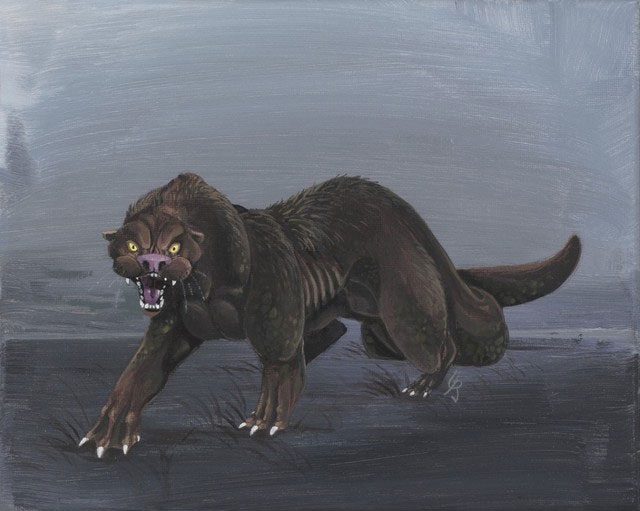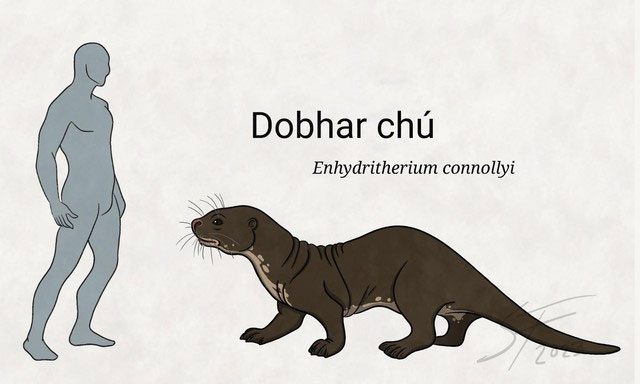When people imagine terrifying underwater creatures, otters typically don’t rank high on the list. However, in Irish folklore, this is quite different.
Irish folklore is rich with mythical beings, among which is the Dobhar-chú, a fearsome creature that has captivated the imagination of many generations. Believed to inhabit the lakes and waterways of Ireland, numerous sightings of this strange creature have been reported over the years.
Interestingly, unlike most folklore, there is actual evidence suggesting that the Dobhar-chú may indeed exist.

The Dobhar-chú is described as a bloodthirsty, terrifying creature, dwelling deep in lakes, rivers, or even the sea, and known to travel great distances both underwater and on land. This creature is notorious for its speed, aggression, and appetite for human flesh. They are said to live in pairs, and if one is killed, its mate will surface from the depths to seek revenge by pursuing and often devouring the attacker. This occurs because, when a Dobhar-chú is near death, it emits a strange, piercing whistle to alert its partner.
Stories of the Dobhar-chú have existed for centuries, and as is common in Irish folklore and oral storytelling, the details about this creature vary from tale to tale. Dobhar-chú is often described as a hybrid of an otter or a dog-like creature.
Witnesses frequently describe it as having sleek fur that is jet black or dark brown, while others claim it is white with black ears or even striped. A relatively recent sighting from 2000 on Owey Island in Connemara described it as a large animal with dark fur and bright orange webbed feet.
According to legend, the creature’s skin possesses magical properties. It is believed to have protective qualities, particularly for sailors who carry a small piece of its skin, which is said to protect their ships from sinking.
Unfortunately, obtaining such a piece of skin is no easy task – according to some folklore, the Dobhar-chú can only be killed with a silver bullet. However, anyone who succeeds in killing it will mysteriously die exactly 24 hours later.

Like the legendary Bigfoot and many other creatures, the Dobhar-chú is known as a mysterious being, a term used to refer to a creature whose existence is not recognized by science.
In fact, there have been reports of sightings of this creature throughout Ireland. They have been spotted in lakes, rivers, and along the coasts of Ireland. For instance, on May 1, 1968, two locals spotted one on Loch Sraheen on Achill Island. British folklore writer Dr. Katherine Briggs also found a reported case of the Dobhar-chú being sighted at Dhu-Hill. It is believed that there are more than a hundred other “normal” otters accompanying it.
Despite many sightings of the Dobhar-chú over the years, there is only one well-documented account.
This account tells of September 22, 1722, when a woman named Grace (Gráinne) Connolly was attacked while washing clothes and bathing in Glenade Lough, a lake in County Antrim. While she was bathing, a gigantic monster emerged from the water and brutally attacked her. Shortly thereafter, her husband – Terence – arrived and discovered the Dobhar-chú lying near the half-eaten corpse of his wife.
In some versions of the story, the monster attacks Terence. He tries to escape, but his frightened horse bolts.

Most recently, in 2000, Irish artist Sean Corcoran and his wife claimed to have witnessed the Dobhar-chú in a lake on Omey Island in Connemara, County Galway. Corcoran described it as large, dark, and having bright orange webbed feet. Corcoran reported: “The creature swam across the lake from west to east in what seemed like just a few seconds.”
In recent years, the Dobhar-chú has drawn the attention of cryptozoologists, who have proposed their own theories. Some suggest that if the Dobhar-chú is real, it may be a descendant of Siamogale melilutra, an ancient relative of modern otters. These fearsome giant otters were the size of a large wolf, weighing around 50 kg, and had a bite strong enough to easily crush the bones or shells of their prey.
The only issue with this hypothesis is that Siamogale melilutra existed approximately 6 million years ago, and its fossils have only been found in China. Additionally, there are giant otters still existing in the Amazon today. However, they are nowhere near large enough to be the Dobhar-chú.
Despite numerous reports of sightings of this creature, it seems quite clear that the Dobhar-chú is merely a legend. It appears similar to other underwater beings that are said to haunt the watery Isles of Britain alongside Selkies, Kelpies, and of course, the Loch Ness Monster. There is even an ancient folklore tale from Scotland about the “King of Otters” on the Isle of Skye.


















































